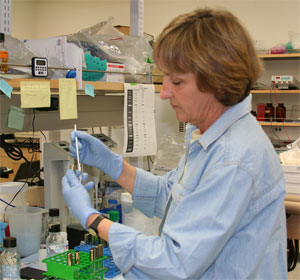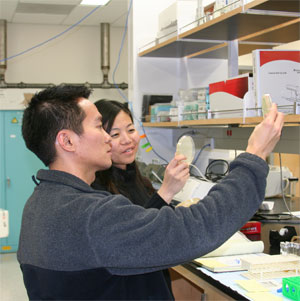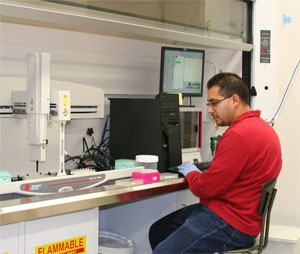Scientific Marriage Gives Birth to New Technology
|
March 20, 2006 -- Once upon a time, computer science and biology were two separate disciplines and nary the twain did meet.
Those days are over. The two fields have merged into synthetic biology, a new branch of science that uses the power of computation to design and build novel biological materials and systems.
At UCI, the collaboration has been productive and profitable, leading to several patents, millions of dollars in research grants, a Computational Biology Research Laboratory housed in the Calit2 Building, and CODA Genomics, a successful spin-off company.
A Meeting of the Minds
The affiliation began about nine years ago, when a group of forward-thinking medical school professors began meeting on a weekly basis with like-minded colleagues from the computer sciences department to problem-solve. “As biologists, we were used to doing one experiment at a time and interpreting our data,” says G. Wesley Hatfield, professor of microbiology & molecular genetics. “Suddenly, with the advent of genomics, we were doing tens of thousands of experiments at a time and we had all this data to process and interpret. We didn’t know how to do it so we had to start collaborating with people who did know how.”
Those people included Rick Lathrop, professor of computer science-computing. Before coming to UCI, Lathrop had worked for 15 years in an artificial intelligence lab at MIT and he had experience in applying computer science to biology.
|
||||
The Tuesday morning meetings were a revelation for all. “We came from totally different cultures and on a scholarly level, it was difficult for us to have the same vocabulary,” Hatfield says, joking that “as biologists, it took us the first six months to explain our problem to the computer scientists, and once they understood the problem and explained the solutions, it took us six months to understand that.”
Despite the initially rocky courtship, the relationship blossomed, resulting in research grants and continued collaboration. Five years ago, the group launched the Institute for Genomics and Bioinformatics (IGB) under the leadership of Pierre Baldi and today, the Computational Biology Research Lab, an offshoot of IGB, operates in the Calit2 Building. In addition, research conducted in the CBRL led to CODA Genomics, a spin-off company developed at UCI through a “virtual incubation” process.
Protein Manufacturing Kits
CODA Genomics sells kits for the manufacture of synthetic genes designed to self-assemble by a complex computer-based process. The gene kits allow customers to produce proteins outside of the human body in a procedure that involves stringing together chains of amino acids specified by the gene, much like pearls on a necklace. The challenge is that the speed at which the amino acids assemble themselves into a protein must be regulated. If they assemble too quickly or too slowly, the amino acids fold incorrectly, damaging the final product.
|
Lathrop developed a sophisticated computer platform that ensures correct timing of assembly ─ a process CODA Genomics refers to as Translation Engineering™ ─ by utilizing algorithms and a number-crunching cluster of high-powered computers. UCI patented the technology and subsequently licensed it to CODA. “The process is proprietary and very specialized and I wouldn’t even try to explain it,” says Albrecht Frauendorf, CODA’s senior vice president of operations. “But the end result is that we get the information right so that each synthetic gene produces high levels of a desired protein.” The company even guarantees its results, an assurance unheard of in the industry until now.
CODA Genomics’ customers ─ mostly pharmaceutical and biomedical companies ─ manufacture proteins to use in developing and testing new drugs. Because the human body manufactures very small quantities of protein, they are expensive to extract, making a quick and inexpensive synthetic protein-production system a boon to research.
Birth of a Virtual Company
CODA Genomics was conceived at a 2003 IGB symposium. Lathrop and Hatfield had explained the process of using an algorithm to control the hybridization temperature of DNA molecules, mentioning synthetic gene manufacturing as a possible application. Several UCI colleagues besieged them with requests to build specific genes for their research.
Those requests led to a search for funding to underwrite the project. Lathrop and Hatfield quickly obtained a prestigious $1.5 million NSF Information Technology Research grant. With this funding and financial support from four UCI deans and the vice chancellor for research, they established the CBRL under the auspices of the IGB. To date, they’ve produced more than 70 genes for 27 campus faculty members.
The CBRL initially was housed in the medical school, but moved to Calit2 last fall. “The multidisciplinary nature of the research, combined with the IT-based approach, made it a natural fit for Calit2,” says Albert Yee, Irvine division director.
Lathrop and Hatfield’s techniques were well-received. IGB advisory board members recommended a spin-off company and suggested that the two researchers contact Bay-area biotech entrepreneur and startup investor Bob Molinari. Molinari liked what he heard so much that he took the helm as founding CEO of CODA Genomics in 2004.
Hatfield and Lathrop, both members of the company’s scientific advisory board, are pleased with the support they received from university leaders. “We have to compliment Dave Schetter and the Office of Technology Alliances, and the administration all across campus,” says Lathrop. “They’ve really been ahead of the curve and very proactive in making this happen.”
While the fledgling company builds its portfolio, Hatfield and Lathrop continue their research, looking for more breakthrough technologies. “There are still things to learn about the proper folding of the proteins and how they will function in different organisms,” Hatfield, CBRL director says. “We’re looking for ways to make the process yield better results.” Another goal involves increasing the number of genes that can be assembled at one time. Such a ‘multiplexed’ system would greatly reduce the cost of manufacturing genes and commoditize the gene market.
“That’s a visionary goal,” says Lathrop, “but we’re supposed to be visionary. If you can conceive it, you can do it.”
– Anna Lynn Spitzer



